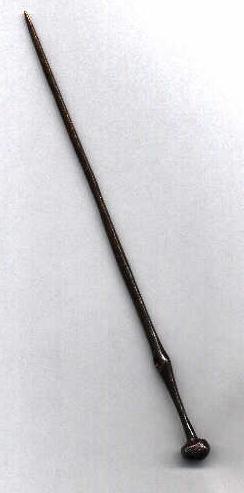
ref.: December 16, "Cloak pin?"

Dear EEF members,
Any ideas or thoughts on the following is much appreciated . . .
I have a 5,500-year-old Egyptian artifact excavated in Palestine.
It looks like a six-inch bronze straight-pin with an eyelet two inches below the head. There are well-worn glyphs still visible around the edges of the head. Under the head and in the eyelet lay thick layers of red paint. The first quarter-inch of the tip is worn shiny, like it was scratched across something rough.
Traditional research methods located 5 such pins at the Royal Ontario Museum in Toronto, Canada - in the FASHION section. The library provided the same information as the Museum. Every source states that this artifact is a "cloak pin", an ancient safety-pin or closure, of sorts. To this end, I disagree . . .
Firstly, the pin is too sharp, heavy and therefore dangerous to wear at the neck (where one bound the cloak). Its weight (14 grams) causes light fabric to pull forward down the torso, and medium-weight fabric twists causing the pin's point to jab into the throat. Also, if the pin were used to hold a heavy fabric, the bronze would have a bow in it, which it does not.
Secondly, from what I gather, ancient Egyptians would have had absolutely NO use what-so-ever for a cloak pin that could only be used safely with heavy fabrics.
Thirdly, the red paint and hieroglyphs are definitely of Egyptian origin, not Palestinian.
Lastly, no fabric would wear down just the tip with such roughness or without scratching anywhere else on the pin . . .
Enter: menket.
When I first saw the menket, I thought, "Wow. That looks just like my pin."
So my bottom line is this: I do believe that my "cloak pin" is really an ancient Egyptian stylus, perhaps even a sort of applicator to put red paint into the etched lines of Pyramid paintings.
I welcome any input you might have on this little puzzle.
Sincerely,
Lise "Hav'ah" Eleanor
havah@sstsystems.net